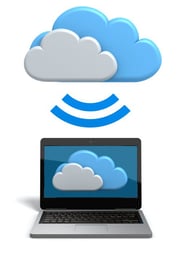Is It a Cloud-Based EHR Software? Signs Your Vendor is Duping You

Do you know what the difference is between client-server, cloud-hosted, and cloud-based technology? Do you know what “the cloud” even is? Trying to figure out what kind of practice management and EHR system you currently have is hard enough without having to deal with all the complicated tech jargon. When things get a little confusing, it’s easy to feel vulnerable to all those tech sharks.
To make sure that you are getting exactly what you want and paid for, let’s start by defining the “the cloud”. Cloud computing, in the most simple of terms, is the storage of information through software that can be found through the Internet. Your information is kept safe and secure in remote servers and allows for you to access your data at any time through any hardware that has Internet browser capabilities. Now that you know a little bit about the cloud, let’s dive into your current practice management system and see if you are actually receiving a true cloud-based EHR… or if your vendor is duping you!
Ask these Questions to Determine if it's a Cloud-Based EHR Software:
- Can you access your practice management and EHR system from anywhere?
If your practice runs off a true cloud-based system, you should be able to access your data through any Internet-capable device. So, if you’re at home and want to prepare yourself for tomorrow’s patients, you should be able to log-in to your practice management system from your home desktop or your tablet. If you can’t do this with your software, you’re probably getting duped.
- Did you ever have to install software?

Chances are that if you had to install software into your office computer, you are not operating off a true cloud-based system. When using the cloud, you will never have to install a program or software onto your computer’s hard drive. That means that you shouldn’t have to click on an icon on your desktop to access your practice management system. You should be able to access everything from an Internet browser!
- Do you ever need the help of an IT consultant?
If you ever require the assistance of an information technology professional, then you probably aren’t in the cloud. I’m not talking about the intern who helps show you how to access your email from time to time; I’m talking about a person who went to school and studied the inside of computers for 4+ years. These consultants are hired on to help with hardware and software located inside the office. The cloud never requires help from an IT consultant because it’s not physically located inside the office.
- Does your computer need to be compatible?
Usually when you’re working through the cloud, you can use whatever kind of computer system you want –an Apple product or a PC. All you really need is an Internet browser. So if your vendor tells you that the practice management system doesn’t work on your computer because it is not compatible, then it is most likely not a cloud-based system.
- Can you change computers without having to buy new software?
Time for a hypothetical situation: you’ve just bought new computers for your office and everyone is super excited because they’re new! So you start them up and expect to be able to use your practice management system almost immediately, but are then stunned to find that you actually need to buy another copy of your software…how discouraging. If this has happened to you, then you are certainly not on a cloud-based system.
- How often are your upgrades? Do they happen automatically?
Usually, individual providers within your practice management system will have upgrades at different times of the year. If you are using a true cloud-based system, these upgrades will happen frequently and they will happen automatically – you won’t even notice it. Other non-cloud systems will bundle these upgrades together, causing you to be behind on the latest. They are also not automatic, warranting you to do it manually. If this sounds familiar, you’re getting duped.
Still have questions about cloud-based software? Watch our on-demand Tech Talk webinar.

